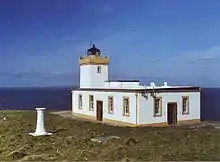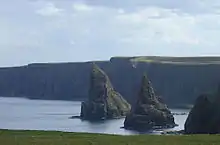 Duncansby Head Lighthouse | |
| Location | Duncansby Head Scotland United Kingdom |
|---|---|
| Coordinates | 58°38′39″N 3°01′30″W / 58.644039°N 3.025120°W |
| Tower | |
| Constructed | 1924 |
| Designed by | David Alan Stevenson |
| Construction | concrete tower |
| Automated | 1997 |
| Height | 11 m (36 ft) |
| Shape | square tower with balcony and lantern |
| Markings | white tower, black lantern, ochre balcony |
| Power source | mains electricity |
| Operator | Northern Lighthouse Board[1][2] |
| Racon | T |
| Light | |
| Focal height | 67 m (220 ft) |
| Intensity | 596,000 cd |
| Range | 22 nmi (41 km) |
| Characteristic | Fl W 12 s |
Duncansby Head (Scottish Gaelic: Ceann Dhunngain[3] or Dùn Gasbaith[4]) is the most northeasterly part of both the Scottish and British mainlands, slightly northeast of John o' Groats. It lies approximately 20 km (12 mi) east-southeast of Dunnet Head, the northernmost point of both the Scottish and British mainlands. Duncansby Head is located in Caithness, Highland, in north-eastern Scotland.[5] The headland juts into the North Sea, with the Pentland Firth to its north and west and the Moray Firth to its south.
Lighthouse
The point is marked by Duncansby Head Lighthouse, built by David Alan Stevenson in 1924.[6]
A minor public road leads from John o' Groats to Duncansby Head,[7] which makes Duncansby Head the farthest point by road from Land's End.
The Duncansby Head Site of Special Scientific Interest includes the 6.5-kilometre (4-mile) stretch of coast south to Skirza Head. It includes the Duncansby Stacks, prominent sea stacks just off the coast.[8]
Atomic Weapon Test
In 2016, it was reported in The Sunday Post newspaper that scientists from the Atomic Weapons Establishment in Aldemarston had proposed a nuclear weapon test on the Stacks of Duncansby in 1953, but that the prevailing wet weather was too much for contemporary electronics and the idea was shelved.[9]
See also
References
- ↑ Rowlett, Russ. "Lighthouses of Scotland: Highlands". The Lighthouse Directory. University of North Carolina at Chapel Hill. Retrieved 10 May 2016.
- ↑ Duncansby Head Northern Lighthouse Board. Retrieved 2016-05-10
- ↑ Gaelic and Norse in the Landscape: Placenames in Caithness and Sutherland Archived 2011-09-21 at the Wayback Machine. Scottish National Heritage.
- ↑ "Cabaan \(Ross\), An Cadha Bàn" (PDF). The Scottish Parliament. Retrieved 26 June 2023.
- ↑ Society of Antiquaries of Scotland (1862). Proceedings of the Society of Antiquaries of Scotland. Vol. 3. Neill and Company. p. 499.
- ↑ "Duncansby Head Lighthouse". The Museum of Scottish Lighthouses. Archived from the original on 27 July 2014. Retrieved 23 July 2014.
- ↑ "Scothighlands - How to drive to Duncansby Head from John O'Groats". www.scothighlands.com. Archived from the original on 27 May 2022. Retrieved 31 October 2019.
- ↑ SSSI citation
- ↑ "Experts nearly dropped an atomic bomb on a Scottish landmark in the 1950s - Sunday Post". Sunday Post. 31 October 2016. Retrieved 8 November 2018.
External links
